This page describes the rules and specifications governing the display of UK vehicle number plates. It is illegal to display number plates that do not meet these requirements.
The information on this page is compiled directly from government sources and from registered number plate manufacturers' trade bodies. It is regularly revised for currency and accuracy.
The current British Standard for number plates is BS AU 145e. The specifications set out in BS AU 145e became mandatory on 1st September 2021 and all number plates manufactured, sold or fitted from that date must comply.
Summary of required, permitted and prohibited features
Number plates must have the following features:
- They must be the correct size as specified in the rules.
- The background of front plates must be the prescribed reflective white colour and rear plates must be the prescribed reflective yellow colour.
- They must have reflective properties complying with British Standard BS AU 145e.
- They must have physical resilience properties complying with British Standard BS AU 145e.
- They must display solid black characters in the prescribed Charles Wright typeface that comply with the rules governing size, spacing, grouping and positioning.
- They must bear the supplier's name and postcode and the manufacturer's mark.
- They must bear the current British Standard number, BS AU 145e.
Number plates must not have any of the following:
- any background colour, pattern or texture except the plain reflective colours specified in the rules and the British Standard;
- any font or typeface except the regulation Charles Wright typeface;
- any character colour, shading, effect or texture except solid black;
- any text except that required or specifically allowed by the rules;
- any badge, emblem image or graphic element not expressly allowed by the rules;
- any coating, treatment or other measure that may affect the reflective properties or legibility of the number plate, either visually or by number plate recognition technology;
- any screws, bolts or other objects that alter the appearance of characters or interfere with legibility.
Number plates may optionally have the following:
- raised 3D characters of plain black colour (known as "4D" number plates) provided that they meet all requirements of British Standard BS AU 145e;
- a coloured border as allowed by the rules;
- a national flag/emblem as specifically allowed by the rules;
- national identifier letters as specifically allowed by the rules.
Fully electric/zero-tailpipe-emissions vehicles may optionally display the approved green 'flash' or panel at the left hand end of the number plate.
Legal specifications
Number plates fonts and spacing
Number plates must now use one specific, mandatory typeface, 'Charles Wright 2001' in black, and the positioning and spacing of the characters must comply with the specifications set out in the illustrations and tables below.
There are two character groups in the current registration plate format: the first comprises the local memory tag and the age identifier code; the second comprises the random letters. The characters must not be divided into any other groups.
For cars, vans, trucks etc
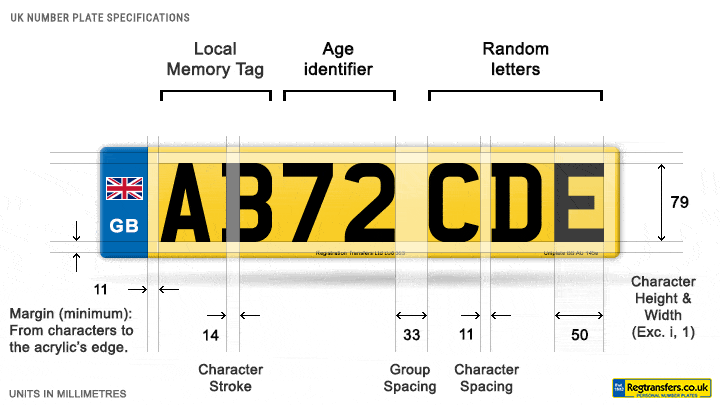
| Item/feature | Measurement (mm) |
|---|---|
| Character stroke | 14 |
| Character height | 79 |
| Character width * | 44 |
| Character spacing | 11 |
| Horizontal spacing between character groups on rectangular/oblong number plates | 33 |
| Vertical spacing between character groups on square number plates | 19 |
| Minimum margin between character and edge of plate | 11 |
| * Excluding i, 1 | |
For motorcycles, scooters and tricycles
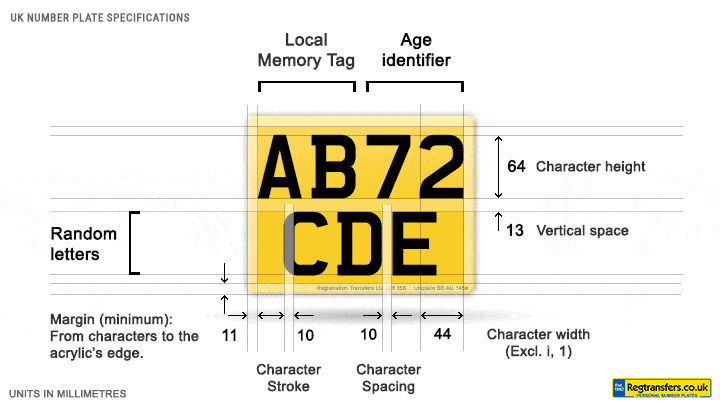
| Item/feature | Measurement (mm) |
|---|---|
| Character stroke | 10 |
| Character height | 64 |
| Character width* | 44 |
| Spacing between characters | 10 |
| Vertical space between the age identifier and the random numbers | 13 |
| Minimum margin between character to edge of plate | 11 |
| * Excluding i, 1 | |
Non-registration markings
All number plates manufactured and fitted to vehicles from 1 September 2021 must be permanently marked with:
- the name or identifier of the manufacturer and the British Standard number BS AU 145e (this should be at the bottom right of the number plate);
- the name and postcode of the supplying outlet of the number plate (this should be at the bottom centre of the number plate).
This information must be displayed below the registration number. The distance between the bottom of the registration mark and these other markings must be at least 7mm.
These markings must be:
- permanent;
- a single shade of non-retroreflecting colour;
- no less than 3mm high and no more than 10mm high.
Other features
The green flash for zero emissions vehicles
The green flash is a rectangular panel positioned at the left-hand end of the number plate. It should be:
- colour Pantone 7481c or very similar;
- between 40mm and 50mm in width;
- retroreflective for 24 hour visibility.
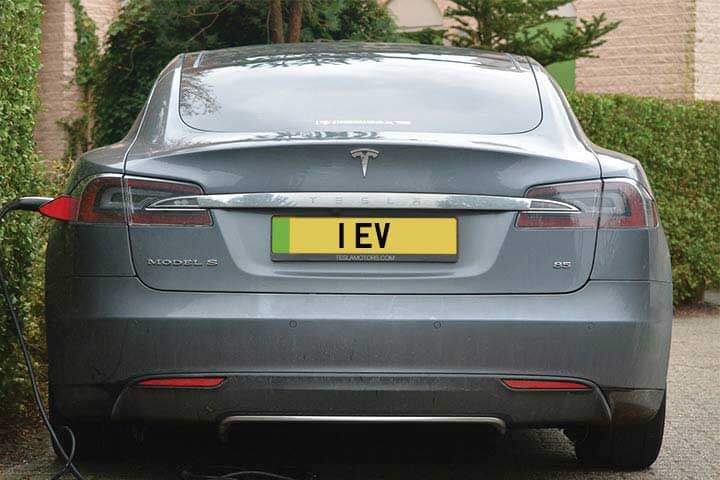
Borders
If a number plate includes an optional border then that border:
- must be permanently printed;
- must be a single shade of non-retroreflecting colour with no pattern or texture;
- must be no closer than 10mm from the edge of any character of the registration number;
- must not be placed above any other markings;
- must be no more than 5 millimetres in width;
- may run level with the supplier details, British Standard number etc, so long as the border breaks to leave space so it does not obscure those details.
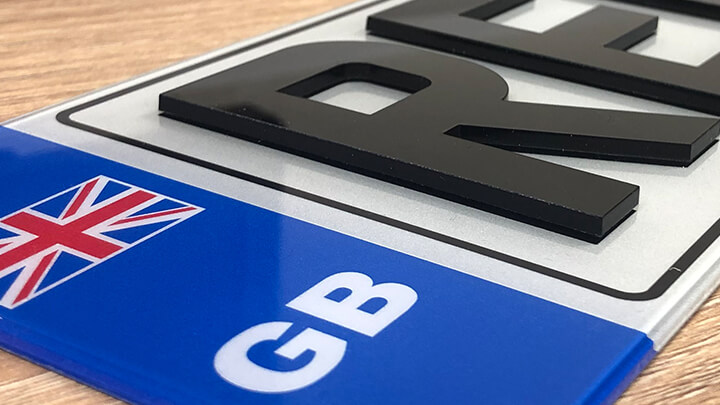
Flags and national identifiers
Flags and national identifying letters may be included on number plates as an option. They are permitted but not required. If present, flags and identifier letters must be positioned at the left-hand side of the number plate.
The flag must be above the identifier letters and neither may be more than 50mm wide.
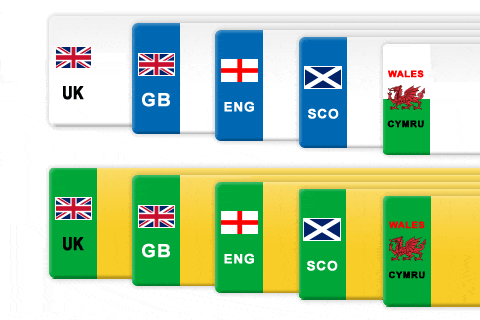
The permitted optional flag variations are:
- Union flag/Union Jack
- Cross of St George
- Cross of St Andrew - also known as the Saltire
- Red dragon of Wales
The permitted national identifier letter options are:
- UNITED KINGDOM, United Kingdom or UK;
- CYMRU, Cymru, CYM or Cym;
- ENGLAND, England, ENG, Eng;
- SCOTLAND, Scotland, SCO or Sco;
- WALES or Wales.
- GREAT BRITAIN, Great Britain or GB are also legal forms but cars displaying GREAT BRITAIN, Great Britain or GB will need to display an additional UK sticker when driving overseas.
No other badges, emblems, logos, images or designs are permitted on number plates. Graphics such as football club badges, religious iconography and cartoon characters are not legal on UK number plates.
Allowances for 'Historic' vehicles
There are concessions for older and vintage cars.
Although they may display standard number plates that conform to the specifications set out above, vehicles built prior to 1st January 1973 are permitted to display the old-style black and white/silver plates of either plastic or traditional metal construction, as an optional alternative. This permission also applies to vehicles built before 1st January 1980 provided that an application has been made to DVLA and the vehicle is registered in the Historic Vehicles tax class.
Refer to the document Vehicle registration numbers and number plates for more information.
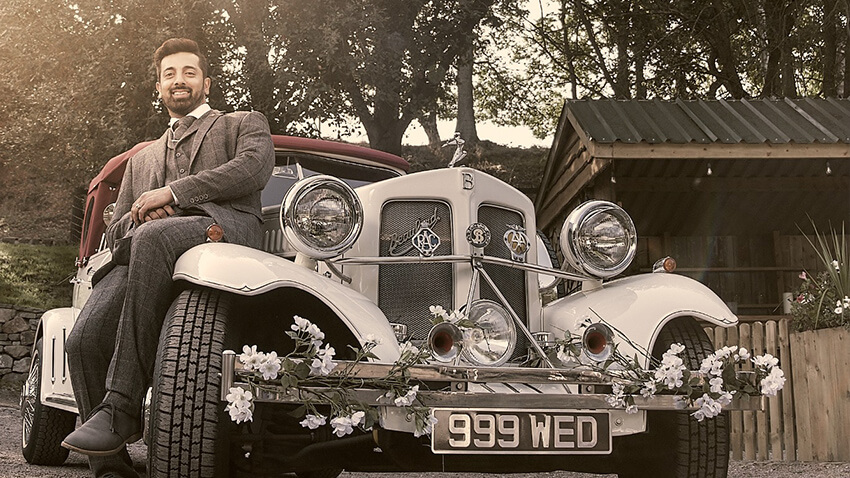
Attaching number plates to vehicles
Adhesive tape or pads are the officially recommended and preferred method of fixing number plates to vehicles.
Bolts or screws are legal methods of attachment, but only on condition that they do not obscure or alter any of the required features of a number plate, or interfere with legibility.
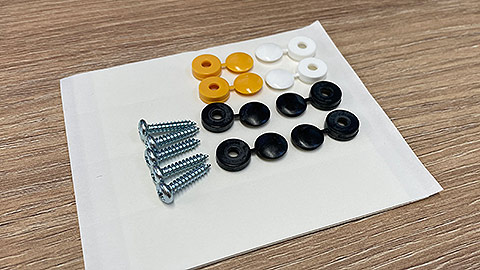
Illegal plates
Basically, for new acrylic plates to be used on UK public roads, they must have all the elements listed under the heading "Number plates must have the following features" in the section near the top of this page.
New plates lacking any of those elements, and/or bearing any of the prohibited features listed under the heading "Number plates must not have any of the following", are illegal to use on UK roads.
Although many people are tempted to purchase new acrylic plates bearing altered or mis-spaced characters, decorative or fancy fonts, football club emblems and textured backgrounds, any and all of these features would make the plates illegal to use on the highway.
For more information, please see our article on illegal number plates.
Driving outside the UK
There are specific rules regarding what must be displayed on UK vehicles driving overseas.
DVLA's website explains it thus:
If your number plate includes the UK identifier with the Union flag (also known as the Union Jack), you do not need a UK sticker. However, you will need to display a UK sticker clearly on the rear of your vehicle if your number plate has any of the following:
- a GB identifier with the Union flag
- a Euro symbol
- a national flag of England, Scotland or Wales
- numbers and letters only - no flag or identifier
If you're in Spain, Cyprus or Malta, you must display a UK sticker no matter what is on your number plate. If you have a GB sticker, cover or remove it before driving outside the UK. You do not need a UK sticker or number plate to drive in Ireland.
General information and advice
Displaying number plates that do not comply with the regulations and the British Standard can result in the following penalties:
- a fine of up to £1000;
- MOT failure;
- withdrawal of the registration number.
Regtransfers strongly advises against any of the following:
- altered character spacing;
- variant fonts or typefaces that do not comply with the rules;
- emblems or graphics that do not comply with the rules;
- non-compliant text effects or backgrounds;
- any other feature or alteration not expressly permitted by the regulations.
Regtransfers will not supply number plates that do not comply with the current regulations.
Share this...